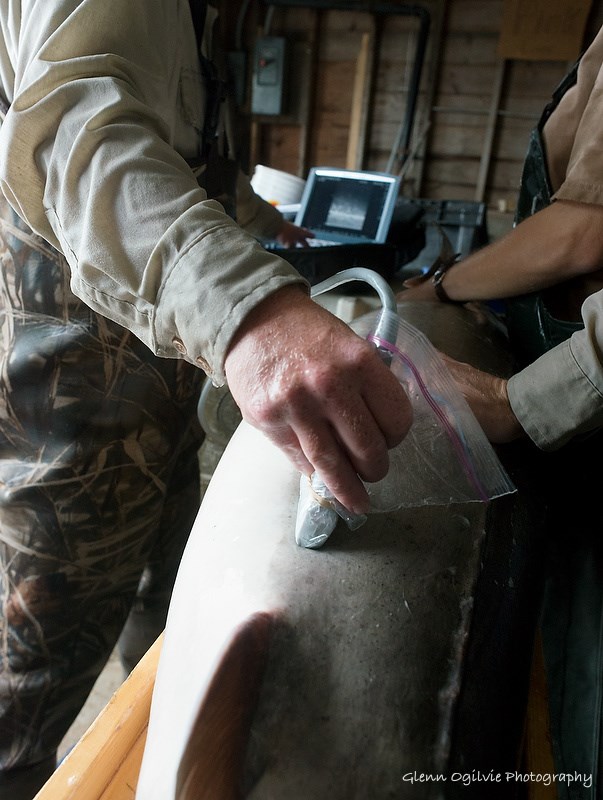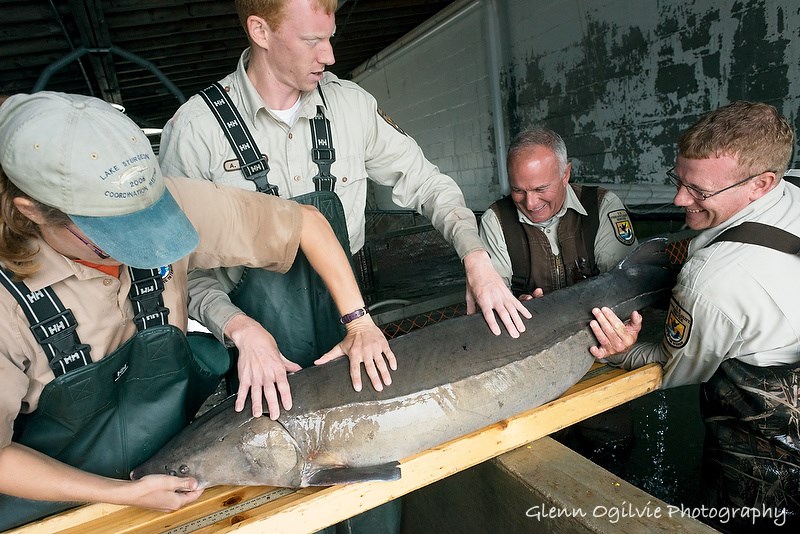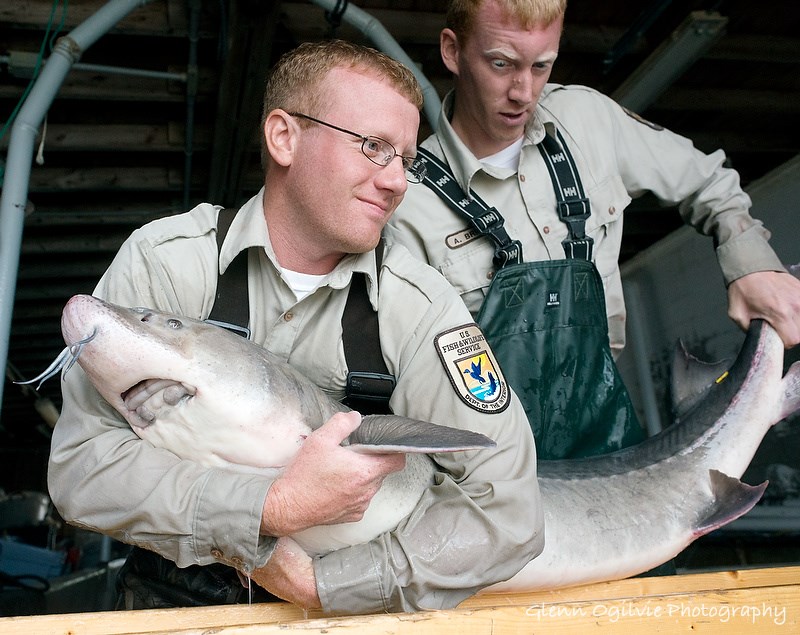U.S. Fish and Wildlife Service biologists Justin Chiotti and Andrew Briggs, wrestle one of 14 sturgeon being tagging at Purdy Fisheries as part of an international restoration effort.
Glenn Ogilvie
She’s the knockout of the group: five foot six, 100 pounds with hazel eyes.
But with her walrus moustache and shark-like fins she and the other sturgeon cruising a holding tank at Purdy Fisheries appear to be escapees from Jurassic Park.
Lake sturgeon are the largest and least understood creature in the Great Lakes, and unlocking their secret lives is the job and passion of James Boase, a biologist with the U.S. Fish and Wildlife Service.
Boase and his team of young biologists were at Purdy’s last week tagging and releasing 14 sturgeon as part of a renewed international restoration effort.
“These fish are so impressive, so captivating,” he said, as each was wrestled to a table, measured and implanted with tracking devices.
“And what’s happening here at the Blue Water Bridge is incredibly important for the recovery of this species.”
A spawning bed in the St. Clair River rapids between the bridge and Purdy’s is the epicentre of the largest population of sturgeon left in the Great Lakes, said Boase, who has been working with the gentle giants the past 15 years.
Understanding their movement and breeding habits can help bring back a fish all but wiped out by overfishing and habitat loss, he says.
The project is backed by provincial, state and federal agencies on both sides of the border, and Purdy’s is playing a key role by bringing ashore sturgeon caught in their trap nets for study and release.
“We’ve always considered ourselves stewards of the lakes and the resource, and we have the ability to help,” said vice-president Stephanie Purdy, the fourth generation at the 112-year-old family business.
“And they’re prehistoric, right. As a society we have a fascination with dinosaurs and to think, in essence, that we’ve got dinosaurs swimming in our tanks is pretty cool.”
Sturgeon are basically unchanged after 150 million years of evolution, enduring everything thrown at them from ice ages to pollution.
The research hasn’t confirmed yet whether their numbers are rebounding, but the signs are good.
“We know there are new fish coming in, but are there more than 10 years ago? We just don’t know that yet,” said fish biologist Justin Chiotti, one of the Michigan-based team.
New and better technology is helping create good base-line numbers, he added.
On this day, Chiotti was also testing an ultrasound unit to distinguish the males from the females, which is hard to tell if you’re not a sturgeon. And better radio transmitters inserted in the tagged fish will be trackable for at least 10 years.
Sturgeon live longer than humans - up to 150 years - and can grow to an enormous size.
In 1986, Purdy’s boated a fish near the Sarnia Riding Club that was seven feet, nine inches (2.3 metres) and weighed 250 pounds (113 kilograms).
And at least a few behemoths still prowl the deep, said Boase. His team recently tagged a seven-footer, and one monster that’s been sighted on the Sarnia spawning grounds could very well be nine feet long, he said.
Ontario banned sport fishing for sturgeon in 2009 and imposed a commercial moratorium the following year. Purdy’s could until then keep a small quota of the fish, which is prized for their meat, oil and caviar.
Sturgeon were once so plentiful they were despised as a nuisance for ripping up nets. They were even dried and stacked like cordwood to fire the boilers of steamboats on the Detroit River a century ago.
Boase’s radio tracking has revealed some sturgeon travel vast distances in the upper lakes before returning here to spawn. And he theorizes that after hatching at least some fry are genetically programmed to fight their way back into Lake Huron against the current.
“There is an incredible resource right here,” said Boase, standing at the river’s edge.
“There are no tributaries remaining that are producing young sturgeon, so this is going to be the source population for the recovery of sturgeon in the Great Lakes.”
- George Mathewson


